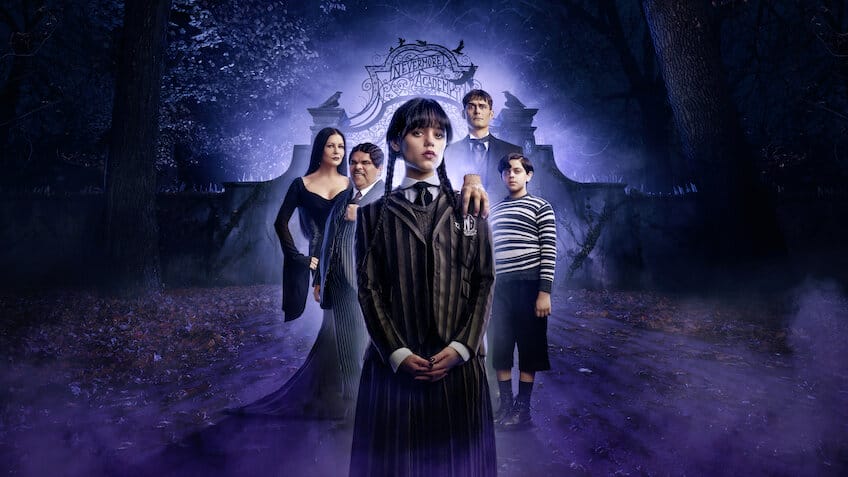The second season of the supernatural mystery series Wednesday has premiered, returning audiences to the gothic world of Nevermore Academy. Following the record-breaking success of its initial run, the new installment finds protagonist Wednesday Addams, portrayed by Jenna Ortega, confronting a new set of challenges that are both deeply personal and existentially threatening. The narrative immediately establishes a dual conflict for its titular character. Upon her return to Nevermore, she must contend with an unwelcome new status as the school’s reluctant celebrity savior. More urgently, she is afflicted by a harrowing psychic vision that foretells the death of her roommate, Enid Sinclair, an event for which Wednesday believes she is directly responsible.
This inciting incident marks a significant narrative pivot from the first season. Where the initial mystery was driven by Wednesday’s morbid curiosity to solve a series of murders—a pursuit that aligned with her natural inclinations—the second season is propelled by an internal, character-driven crisis. The mission to save Enid elevates the emotional stakes, forcing Wednesday to act not from intellectual detachment but from a burgeoning, if unacknowledged, sense of loyalty and friendship. This shift places her developing relationships at the core of the plot, using the season’s new supernatural mystery as the crucible in which these bonds are tested.
A More Perilous Year at Nevermore
The season’s plot is structured around Wednesday’s desperate “time-bomb mission” to alter the future and prevent Enid’s foretold demise. This central narrative is interwoven with several interconnected threats that expand the scope of the series. The story opens before Wednesday’s return to school, revealing that she spent her summer break actively honing her psychic abilities by hunting a serial killer known as the Kansas City Scalper, played by guest star Haley Joel Osment. This sequence establishes her development into a more proactive, though perhaps reckless, investigator. However, it also introduces a critical vulnerability: her psychic powers have become unstable, failing her at a crucial moment during her confrontation with the killer.
This unreliability of her primary tool for control sets the stage for a season-long arc that deconstructs Wednesday’s perception of her own infallibility. She arrives at Nevermore believing she is in command, only to be immediately confronted by a future she cannot control and a school environment where, as the showrunners have indicated, nothing is as it seems. The betrayal by Ms. Thornhill in the first season has had a lasting impact, shattering Wednesday’s trust in authority figures and making her more cynical and self-reliant. Adding to the peril is the unresolved cliffhanger from the first season: a mysterious stalker who continues to send threatening messages, confirming that the threats to Wednesday and Nevermore were not fully resolved.
Further complicating the central mystery are deeply buried Addams family secrets, which are teased to have “deadly consequences” and appear to be intrinsically linked to the new dangers at Nevermore. This narrative direction is accompanied by a deliberate tonal shift. The series has consciously moved away from the romantic subplots of the first season, specifically the love triangle involving Wednesday. Instead, it leans more heavily into horror, with Jenna Ortega, now also serving as a producer, noting that the season is “bigger, bolder, gorier, a bit darker”. The creative team has cited vintage slasher films such as Carrie and Prom Night as stylistic and thematic inspirations. This removal of romantic elements is not merely an aesthetic choice; it serves a distinct narrative function. By eliminating the genre-typical safety net of a romantic interest, the story isolates Wednesday further, forcing her to confront the season’s terrors without distraction. This makes her vulnerability more acute and her ultimate reliance on her friendships, particularly with Enid, more significant and hard-won. Ortega has also noted that Wednesday herself becomes more of a source of horror, at times functioning as “a little bit of a jump scare herself”.

The Evolving Ensemble: Familiar Faces and New Dynamics
The second season sees Jenna Ortega’s role expand beyond her on-screen performance. As a producer, she has gained significant creative input, contributing to script development, character arcs, and even specific production elements like prosthetic designs. Her character’s journey this season focuses on navigating her unwanted fame within Nevermore while grappling with the emotional weight of her premonition.
The Addams family’s presence is substantially increased, serving to externalize Wednesday’s internal conflicts. Her ongoing struggle for independence is now physically manifested by her family’s integration into her school life, forcing confrontations she would otherwise avoid. Morticia Addams, portrayed by Catherine Zeta-Jones, takes on a significant new position at Nevermore, creating a fresh source of mother-daughter friction that is central to the season’s exploration of family dynamics. Luis Guzmán returns as Gomez Addams, alongside Fred Armisen as the eccentric Uncle Fester.
Wednesday’s younger brother, Pugsley Addams (Isaac Ordonez), enrolls as a student at Nevermore, granting him a more substantial role. The narrative follows his discovery of his own supernatural abilities and, according to Ordonez, places him in the path of the season’s primary antagonist, with whom he shares a “very deep connection”. Enid Sinclair (Emma Myers) is positioned at the heart of the season’s emotional core, not only as the subject of Wednesday’s vision but as a character who has grown more confident in her own werewolf abilities, returning as “a bit more of a badass”.
Other returning characters see their roles evolve. Bianca Barclay (Joy Sunday), Wednesday’s former rival, enters into an “uncertain alliance” with her. Tyler Galpin (Hunter Doohan), the Hyde from the first season, remains a menacing presence, shown imprisoned at the Willow Hill Psychiatric Center but still capable of transformation. Eugene Ottinger (Moosa Mostafa) becomes Pugsley’s new roommate, expanding his involvement in the school’s daily life. Jamie McShane also returns as the now-disgraced former sheriff, Donovan Galpin.
An Influx of Newcomers
A significant number of new characters are introduced, expanding the world of Nevermore and its surrounding community. Steve Buscemi joins the cast as Barry Dort, the new principal of Nevermore Academy. His character is described as the “polar opposite” of his late predecessor, Larissa Weems, championing outcast pride to an extreme by advocating for “normie exclusion”.
The Addams family itself expands with the arrival of Grandmama Hester Frump, played by Joanna Lumley. She is introduced as Morticia’s wealthy and manipulative mother, the proprietor of a funeral home with her own distinct agenda for the family’s legacy. In a casting choice that pays homage to the 1990s Addams Family films, Christopher Lloyd joins the series as Professor Orloff, Nevermore’s longest-tenured teacher. Described as a stern disciplinarian, he takes a particular interest in the rebellious Pugsley. This casting creates a compelling meta-narrative layer; in Season 1, the villain was played by Christina Ricci, an actor with a legacy connection to the franchise. By casting Lloyd, another legacy actor, in the role of a teacher who targets an Addams sibling, the series deliberately sets up audience expectations, making Professor Orloff either the likely villain or a sophisticated red herring.
Other major additions include Thandiwe Newton as Dr. Rachael Fairburn, the pioneering lead psychiatrist at Willow Hill who oversees Tyler’s treatment, and Billie Piper as Isadora Capri, Nevermore’s new music director and a mentor to Enid. Pop superstar Lady Gaga makes a guest appearance as Rosaline Rotwood, a legendary former Nevermore teacher whose path crosses with Wednesday’s. The cast is further rounded out by Joonas Suotamo taking over the role of Lurch, Luyanda Unati Lewis-Nyawo as Jericho’s new sheriff, and guest appearances from Heather Matarazzo, Frances O’Connor, and Anthony Michael Hall. The new season also confirms the departure of Percy Hynes White (Xavier Thorpe) and Naomi J. Ogawa (Yoko Tanaka), a move consistent with the narrative’s shift away from the first season’s romantic subplots.
The Craft of a Modern Gothic Vision
The production of the second season underwent a significant logistical change, moving from Romania to Ireland. This relocation, prompted by logistical challenges during the first season, has become a key creative asset. Now the largest production ever to film in Ireland in terms of financial spend, the series utilizes locations in County Wicklow, Dublin, and Offaly, including the historic Powerscourt Demesne and Charleville Castle. The creative team has leveraged the “epic spectacle” and “timeless beauty” of the Irish landscapes to visually represent the season’s “bigger, bolder” narrative ambitions. The scale of the natural environment is used to mirror the increased scale of the story’s emotional and supernatural stakes.
The aesthetic remains rooted in the gothic vision established by executive producer and director Tim Burton, who returns to direct four of the eight episodes, including the premiere and the finale. The visual language continues to draw inspiration from Charles Addams’s original, macabre cartoons rather than previous screen adaptations. Production designer Mark Scruton mixed contemporary elements like vending machines with period furniture from various eras to convey that the school had evolved over time. Burton’s directing style is described as fluid, often beginning with the actor’s performance to determine camera placement rather than adhering to rigid plans. Cinematography and production design emphasize tangible, practical sets and atmospheric lighting, continuing the visual motif of contrasting darkness and color that defines the relationship between Wednesday and Enid. The remaining episodes are directed by Paco Cabezas and Angela Robinson, maintaining a cohesive visual tone.
Costume design, overseen again by Colleen Atwood, plays a crucial role in signaling the season’s thematic shifts. A notable choice is a dark red dress worn by Morticia Addams, a striking departure from her iconic, exclusively black wardrobe. This decision serves as a visual metaphor for the show’s broader creative philosophy: honoring the spirit of the source material while refusing to be slavishly bound by its iconography. The color choice itself is layered with potential meaning, suggesting mourning for the deceased Principal Weems, foreshadowing new danger, or symbolizing the enduring passion of her marriage. Atwood’s detailed approach extends to the student body. Wednesday’s gray-and-black Nevermore uniform is a custom creation, reflecting her “allergy to color,” with its stripes painted on rather than woven to create a softer gradient. This is directly contrasted with Enid’s wardrobe, which uses the same principles of strong graphics and geometrics but in a vibrant, colorful palette, visually reinforcing their “opposites” dynamic. The music, a key component of the show’s identity, is once again composed by Danny Elfman and Chris Bacon, who return to provide their distinctive whimsical and haunting score.
Reinterpreting a Macabre Legacy
The series continues to carve its own unique space within the Addams Family canon. Its success as a modern adaptation stems not from simple replication of the past, but from a thoughtful deconstruction of it. The show takes the core conceit of the Addams family—a clan that is “mysterious and spooky” but sees itself as perfectly normal—and places it within a narrative framework where that worldview is actively challenged by tangible consequences.
Previous iterations of the Addams Family, particularly the original cartoons and the 1960s sitcom, often treated death and violence as punchlines, with morbid humor derived from a context free of lasting harm. The humor relied on perfect timing, cutting away from the grisly results before they were seen on screen. This series fundamentally alters that formula by introducing genuine stakes. As a serialized drama, it cannot simply cut away without creating continuity errors; it must show the consequences. The potential death of a friend, the unresolved crimes of a parent, and the threat of a stalker are treated with narrative gravity. This forces Wednesday to react with genuine emotion and determined action, moving her beyond her detached, cynical persona. The show reveals her family’s morbid humor to be a “bluff” that reality calls them on, proving that murder is, in fact, bad, and no one is killed as a punchline. By giving depth to all its characters, the series ensures that “nobody is just a joke, and as a result, neither are their deaths”. The central tension is therefore not merely a conflict between “outcasts and normies,” but an internal struggle within Wednesday herself, pitting her inherited, consequence-free philosophy against the inescapable reality of pain, loss, and the complex responsibilities of friendship.
Release Information
The second season of Wednesday consists of eight episodes, released on Netflix in two parts. The first part, containing episodes one through four, premieres on August 6, 2025. The second part, with the final four episodes, will be released on September 3, 2025. The titles for the first four episodes are “Here We Woe Again,” “The Devil You Woe,” “Call of the Woe,” and “If These Woes Could Talk”. The series has also been renewed for a third season.























